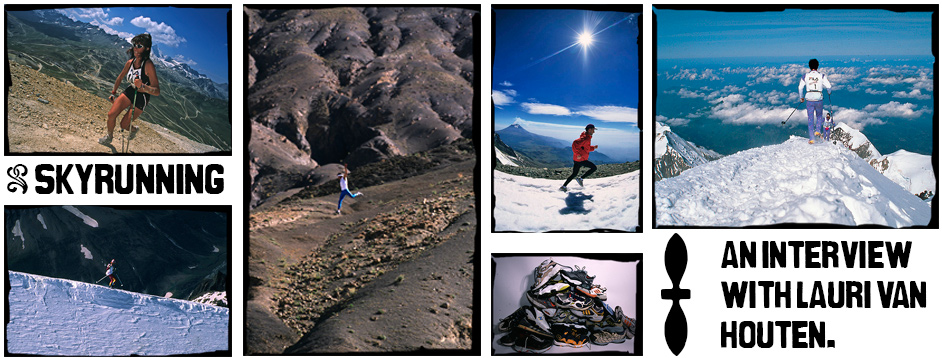2012 was something of a breakthrough year for the International Skyrunning Federation. Their ‘Skyrunner World Series’ attracted the cream of international trail and ultra running to the start lines of many of their spectacular races and the general consensus was ‘mind-blowing’. The jaw-dropping and eye-popping locations and lung-burning steep and technical courses, not to mention the outstanding performances, combined to ignite a massive groundswell of support for the concept of skyrunning. 2013 seems certain to build on the success of last year with even more amazing race destinations added to the calendar, including the ISF’s first 100 miler, plus many of the worlds best trail runners have signed up and are ready to resume rivalries. Its gonna be one hell of a show.
However, what we see coming to fruition now is a result of the vision and 20 years of hard-work by the ISF’s co-founders Marino Giacometti and Lauri Van Houten. I got the chance to talk to Lauri about how it all began, the pioneering early days and the breaking of a new dawn for the organisation.
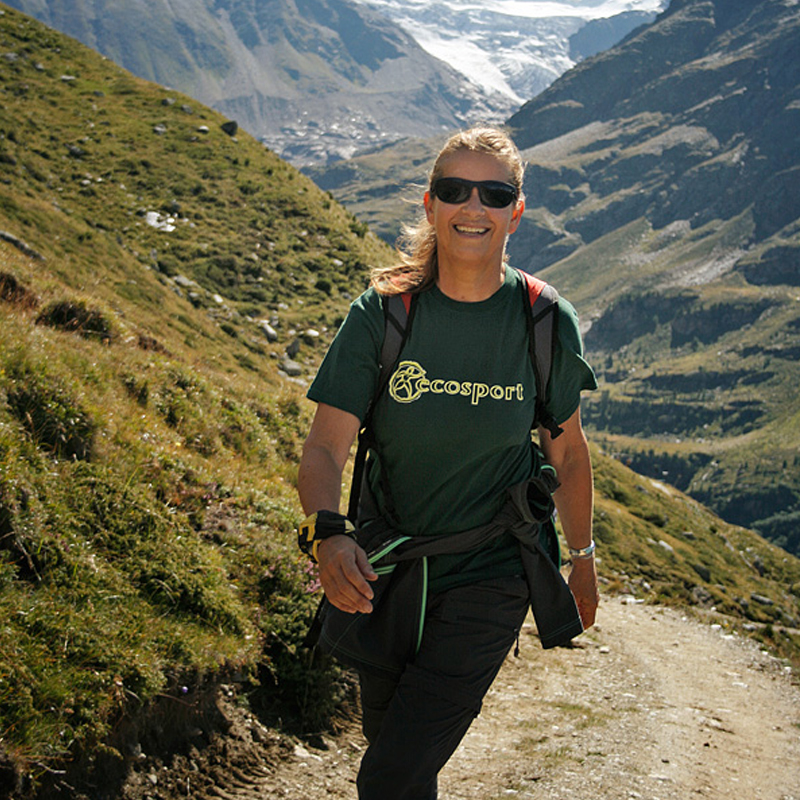 Skyrunnings co-founder Lauri van Houten, feeling right at home © ISF
Skyrunnings co-founder Lauri van Houten, feeling right at home © ISF
So going back to the beginning Lauri, before the whole concept of Skyrunning as an organisation, were you guys mountaineers who just loved moving fast and light in the mountains?
Marino was an accomplished mountaineer (two 8,000m summits and speed records on many others in the Himalayas, Alps and Andes). He was influenced by the new mountaineering tendency in the eighties where it was natural to bag not just one, but maybe three peaks in one day. “Fast and light” was his motto. He established many records over the years: Pumori, Genoa – Mont Blanc, Genoa – Monte Rosa (both with road bike then on foot to the summit in under 24 hours). As a child, he would run 3 km to school, back for lunch and then back to school and home again – 12 kilometres a day! Since then, his focus has always been on his watch, setting himself new records and seeking new challenges.
My own background is skiing, we can talk a little about that later on.
Was there a sense back then that to settle the FKT (Fastest Known Time) on a specific route the best thing would be to have a race? For example your first race from Courmayeur to Mont Blanc’s summit?
Both. Initially Marino set out (with others) to establish new records, or to beat existing ones and then to have a race there to reduce the time even further. With time, participants grew and so did the level, with records continuously being broken. Some, like Bruno Brunod’s record on the Matterhorn, look like they are here to stay, although Kilian Jornet will attempt it this year – probably the only candidate for the job. The most extreme races, like Mont Blanc and Monte Rosa, launched the skyrunning concept, although they were reserved for just a select few. Over the years, Marino, apart from his own exploits, supported the dreams of some of “his” athletes, like Brunod’s Matterhorn record, Brunod and Meraldi’s Everest attempts, Cho Oyu, Shisha Pangma, Aconcagua… The races weren’t designed to substitute FKTs – the idea was to organize races to make skyrunning more popular. In the beginning we created and personally organized over 80 races worldwide. Now there are many so, thankfully, we limit ourselves to “just” coordinating them – a mammoth task!
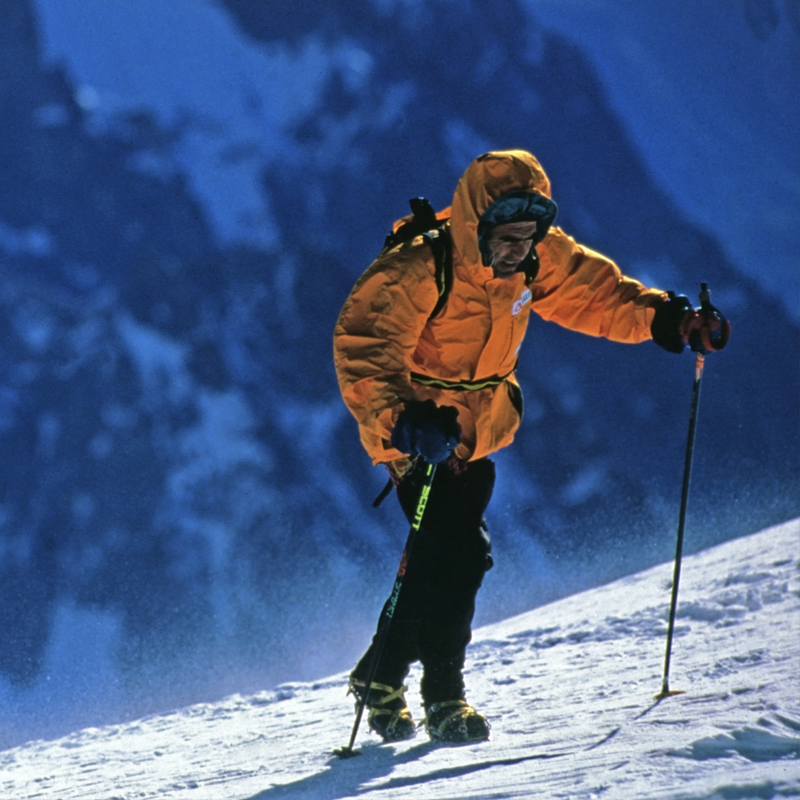 Marino Giacometti during his record-breaking Genoa to Mont Blanc summit 1997 © Pier Orler
Marino Giacometti during his record-breaking Genoa to Mont Blanc summit 1997 © Pier Orler
It seems like there was a very short timeframe between the first race to Skyrunning been supported by Fila and going global, it must have been a whirlwind ride?! Can you tell us a little more about that time?
It was indeed a whirlwind. As soon as the sponsorship was in place, we went to New York to meet with the Fila PR people and to recce potential locations. We had studied where potential races could be run on the Fourteeners, but access, accommodation, logistics – some sense had to be made of it – so we chose Aspen, and Castle Peak. The following morning we were on a flight to Denver and Marino was fast on the tracks (bear tracks in this case) up the mountain….Other locations followed: Tibet (which we had reccied the previous year), Mexico….We had chosen Popocateptl but an eruption was brewing so the nearest volcano, Iztazhuatl (5,200m altitude) was selected. The race was repeated five times. Marino was very much interested in the physical and psychological aspects of this new kind of running and right from the start involved researchers, the first to study athletes at altitude, in the field, rather than in the lab. Twenty-four research protocols have been published in scientific journals and skyrunning has been the subject of many sports medical conventions. It is still on-going with a recent study of how skyrunners breathe and how it relates to performance. The next step was to put a “Dream Team” together – not an easy job. Apart from the Italian pioneers like Champretavy, Greco, Meraldi, Brunod, they included American runners, Matt Carpenter, Danelle Balengee, Lyndon Ellefson, Ellen Miller and later, Mexican Ricardo Mejia. It was like a big family with the team, researchers, photographers and tv crew travelling to some of the world’s most spectacular and logistically challenging locations like Nepal and Tibet. It was an incredible adventure in every sense – the feeling of breaking new ground. Happy days.
A friend, one of the first high altitude runners, constructed all the technical gear in a small laboratory: shoes, crampons, poles…
That sounds like an amazing time, but what about the gear!? We are pretty spoilt now with shoes, clothing and equipment for trail and mountain running but what kind of stuff were you using back in the early days?
Good question! The photo below is from 1992 on Mont Blanc. This was the year before Fila, where Marino later worked with their R&D. In those days, there was more or less nothing on the market. He had the whole kit specially made up in a laboratory from fabrics used for winter cycling: a long sleeved top, tights and a cyclist’s bib with a back pocket for a spare wind jacket, or food. Trail running shoes hadn’t yet been invented. A friend, one of the first high altitude runners, constructed all the technical gear in a small laboratory: shoes, crampons, poles…The shoes were either lightweight cross-country skiing shoes or road running shoes adapted with cross-country shoe uppers to provide more protection. For racing on the snow-covered Alpine glaciers, special crampons were made from aluminum or javelin shoes with 2cm spikes were used. Ski poles have long been employed in the more technical runs to assist on the uphill or as a safety measure in case of falls. These were also specially made in the lab by applying grips used for mountaineering combining an ice axe, then these were applied to curved downhill ski poles. This was a new discipline with a new breed of athlete that wanted to travel fast and light. Everyone else on the mountain was heavily dressed with boots, rucksacks, ropes…. During those years, Marino continued with his running footwear consultancy for Fila, developing prototypes for elite athletes (winning the New York Marathon in 95 and 96 and Boston). The first trail running line was developed from the running shoes and launched in 1998. At the same time, Fila launched an Outdoor sector featuring a “Skyrunner®” apparel line. Unfortunately the project ended together with Fila, although some technical concepts in the footwear have survived today.
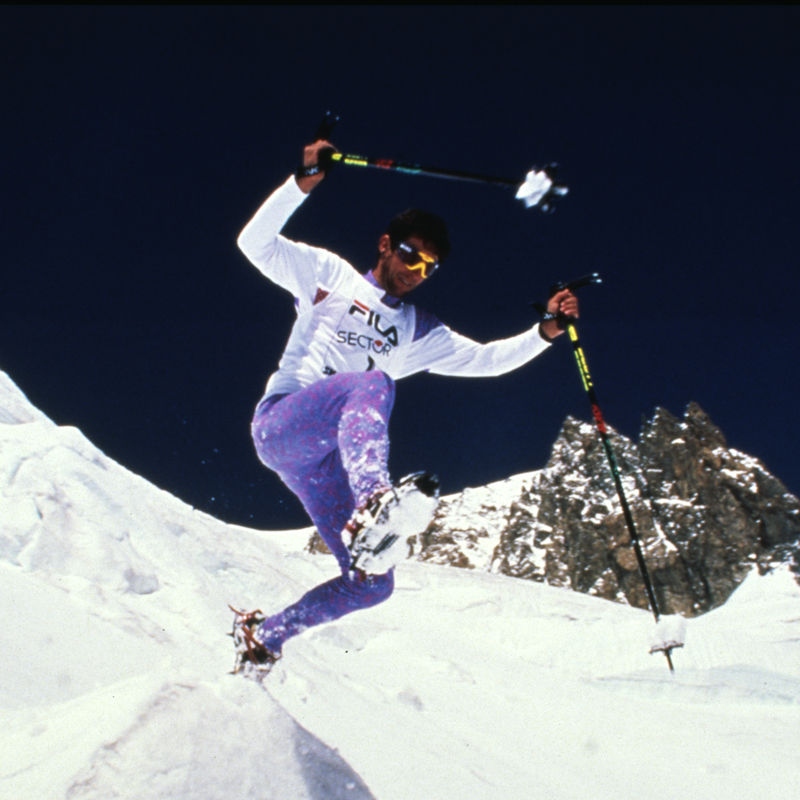 Adriano Greco stylin’ on Mont Blanc during the early years of skyrunning, 1992 © Dario Ferro
Adriano Greco stylin’ on Mont Blanc during the early years of skyrunning, 1992 © Dario Ferro
That is really fascinating Lauri, are there any plans or dreams to team up with a manufacturer now or in the future to create a specific Skyrunning range of clothing and footwear?
We have various projects ongoing. For example the latest scientific research protocol mentioned above on how skyrunners breathe at high altitude and how it affects their performance uses an “intelligent” T-shirt with sensors able to precisely measure multiple physiological parameters. The tests aren’t limited just to sport, but can be applied to testing and accurately comparing different materials for apparel, footwear and equipment – how they influence performance in various conditions, how much energy is saved or absorbed in the case of soles…these are just some examples of the scope of these tests. We’re also working with a yarn manufacturer with a view to creating products aimed at increasing safety in Ultra races. We’re more oriented towards ingredient brands and technology, to benefit the sport as whole, rather than joining up with a single brand.
And going back to the early days, were there much women competing back then? If not, when did they start getting involved?
In Europe women represented 5-10% of the field while in the US, the participation of women was much greater – 40-50% in some races. The results are similar today for the marathon distance. A few pioneers: Bruna Fanetti and Gisella Bendotti (Italy), Helen Diamantides (Great Britain), Alexia Zuberer (Switzerland), Ellen Miller, and later Danelle Ballengee (USA)…..Interestingly, both Zuberer and Miller became accomplished Himalayan mountaineers thanks to their skyrunning experiences in Tibet. It’s also interesting to note that despite the disparity in numbers proportionally, the gap between top men and women seems to be closing fast. We’re seeing women runners finish in the overall 10/15, sometimes even less… coining the term “chicked” when men are overtaken by a woman (or in the case of Anna Frost – “Frosted”!). Marino affirms (and the race results testify this) that women perform better at high altitude (in hypoxy) than men, of the same level of course. The higher they go, the better they perform. Mind the gap (!)
For sure, Why do you think there is such a disparity between US and European percentages of female runners though?
It’s probably cultural. My personal view is generally speaking American women, women in northern Europe and the commonwealth countries tend to be more independent and adventurous than women from Latin countries. The figures are probably similar in other endurance sports but as they evolve, no doubt we’ll see more and more women participating. Our promotion strongly focuses on women.
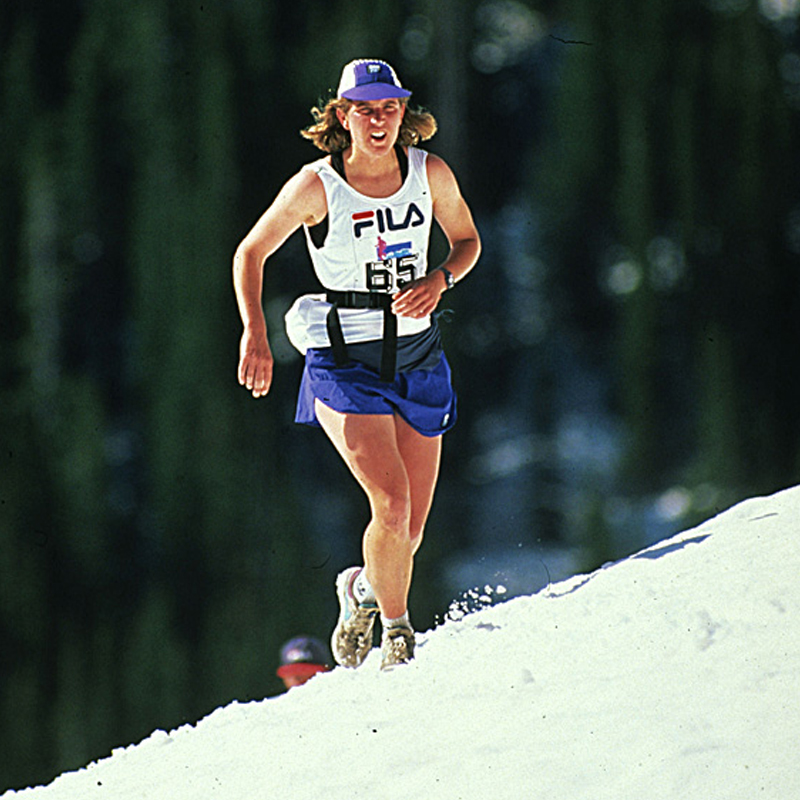 US trailrunning legend Danelle Ballengee skyrunning in Aspen © Dario Ferro
US trailrunning legend Danelle Ballengee skyrunning in Aspen © Dario Ferro
1995 saw the foundation of the FSA and the sport becoming more organised. Did Fila stay involved with Skyrunning during the years that followed? If not how were the races and promotion financed during this time?
An exceptionally long and close partnership, Fila was on board from 1993 to the company’s demise in 2002. We had support from other sponsors over the years, both during and afterwards: Vibram, Sector Watches, Cellfood, Polar, Polartec, Buff and Arc’teryx. An important source of funding also comes from local Councils and Regions and Tourist Boards as the events represent a tourist attraction in mountain resorts.
Apart from Enrico Frachey, Fila CEO, in the beginning everyone thought we were crazy.
2008 saw the setting up of the ISF and it seems that this coincided with a worldwide boom in trail and mountain running, did you guys see it coming?
It was a coincidence. In a way we didn’t see it coming as, having worked on the project for 15 years, it seemed to us a rather long but natural evolution. We realize we had been light years ahead – of the sport… and the industry. Apart from Enrico Frachey, Fila CEO, in the beginning everyone thought we were crazy. We were creating and organizing races at seriously high altitude in logistically difficult locations with a “Dream Team”, a research project, media crews – just like Salomon is doing today. The only difference is social media hadn’t arrived, unfortunately. I believe the onset of social media was instrumental in creating the boom. The figures speak for themselves. Today, it’s an indispensable tool to keep in touch with the community.
2012 proved to be something of a breakthrough year for the ISF, you launched the Ultra series and attracted some of the biggest names in the sport, both European and US runners, to the starting lineups of most of the races. It seemed like a milestone in the sport becoming more mainstream. How does it feel now looking back on the year that just finished?
Phew! It wasn’t easy. It was the result of a renewed vision and inspiration, the need to take the sport to the next level, create a proper strategy and follow our gut instinct. The previous year we had met with the Olympic Committee and realized this road wasn’t for us. When we came out of the meeting we were, for some hours, dazed. Being an Olympic sport is what everyone dreams of, but we must be practical. In the end, our arena is the mountain, not the artifice of a stadium. Thankfully, the athletes all realize and support this.
At our launch event at the Transvulcania Ultramarathon on the island of La Palma, we held a seminar with some of the world’s top athletes with a view to presenting Skyrunning to a new generation and to get their feedback. It was quite a revelation! Rather than wanting more mainstream races, they applauded and welcomed the hard-core Skyrunning style – steep and technical! This inspired us and gave us the confidence to continue on our path without watering the sport down to appeal to a wider target.
The launch of the Ultra Series had been brewing for some time – we knew we had to go down that road sooner or later and now the time was ripe. Kaboom!
So have you given up on the Olympic aspirations completely Lauri? Were they asking for too many sacrifices from what the true spirit of Skyrunning is, for it to be considered as a potential Olympic sport, a case of having to sell your souls!?
To gain Olympic recognition there are a number of basic steps, such as having 50 member countries for example (currently we have 22 although every year more countries are joining). The main point is, skyrunning takes place in the mountains and the Olympics don’t. The only possibility would be to hold an “Outdoor Olympics”, the summer version of the Winter Olympics, with the participation of all those sports that take place in the mountains…a dream, a long way off. Certainly it could be possible to include the shorter distances like, SkySpeed (100m vertical), or another of our projects, skyscraper racing, would work well. Even the Vertical Kilometer® would mean laps or take part in the Winter Olympics, on snow.
It seemed like the US runners were blown away by the sheer technicality of the courses in Europe compared to most US races and its clear they loved it. For 2013 you have chosen to host UROC, the final race in the Ultra Series, in Vail, Colorado. Do you see this cross-pollination between the two continents as essential for the growth of the Skyrunning?
Running at altitude can’t just be a European sport. There are mountains all over the world, albeit with different characteristics. The Alps, where Skyrunning was born and thrives, is the most typical: steep and technical, following Marino’s original concept – from sea to sky or the logical route from a town or village to the summit of the mountain. However, other locations perfectly epitomize the concept: Ben Nevis, Pikes Peak, Elbrus, Kinabalu, the island of La Palma…The American mountains tend to be less steep and technical, but plenty can be done there!
US runners are finally getting a taste of Skyrunning events in Europe and we believe that a greater number of European runners will want to participate in US races with a Skyrunning “feel”. We believe both sides of the pond can learn from each other and want to compete in the same events. We also foresee growth in Asia and South America.
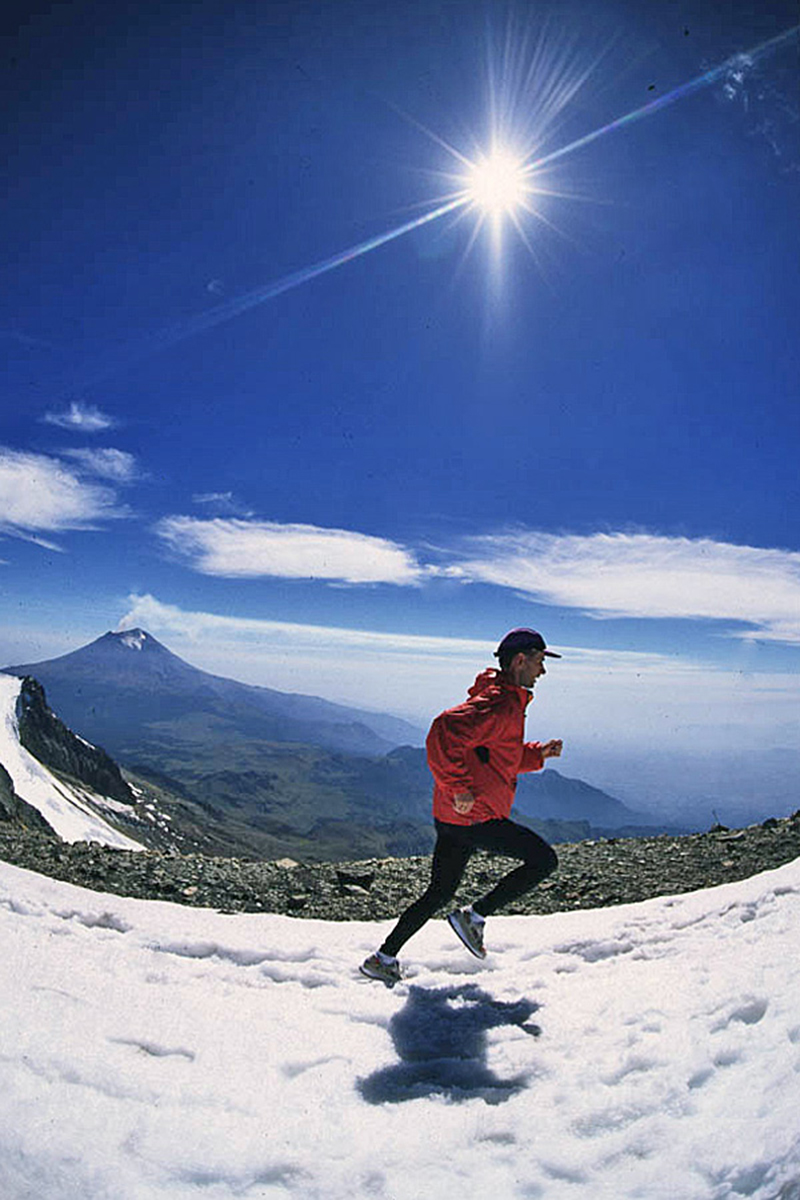 The one and only Matt Carpenter cruising on Iztazhuatl, Mexico in 1997 © Scott Markiewicz
The one and only Matt Carpenter cruising on Iztazhuatl, Mexico in 1997 © Scott Markiewicz
Cool, but many fear the increased prize money and exposure for the sport will erode some of the spirit that exists, it seems like it’s a balancing act to get it right. Whats your view of this?
I think it’ll take a lot and a long time – if it ever happens, like in road racing or cycling for example. So far, the top runners are purists and are more interested in the course and the competition, rather than going just for the prize money. Races like ‘Run Rabbit’ have made it their war-horse, but I don’t see it making a huge difference as races with comparatively little or even no prize money still have great line-ups.
We believe strongly that runners should be rewarded for their incredible efforts -it’s in our rules – so higher prize money is right, especially down the line. The next step, we believe, is that the industry must invest more in their athletes so they can become professional and not have to juggle a job and training. I foresee more professionalism in the sport – but without necessarily losing the spirit (at least if we have anything to do with it)!
And it seems like that is starting to happen now right? The traditional ‘Mountain’ brands seem to be embracing trail and mountain-running more and more. Obviously Salomon is flying the flag but it seems the other brands; TNF, Mountain Hardwear, Patagonia etc are now also offering their sponsored athletes more opportunities to become more pro?
It’s a good sign, but we’re just at the beginning. The fact is trail running, the races, the spectacular locations and especially the heroes, have a story to tell. Compared to main stream sports it represents a life-style, a philosophy – which has a big appeal and a wide reach. It’s therefore an interesting vehicle for the industry to promote their brand, their products. We’re promoting the SWS to teams, which incidentally are also ranked, and we’re working with the brands to facilitate their athletes and promotion. This year’s European Championships and the 2014 World Championships are open, which encourages sponsors to enter their runners and get visibility. It looks promising. Let’s see where we are at the end of the year.
In many races in Europe, these events represent a key moment for the local people, who come in droves to support the runners…every step of the way.
Marino said in a previous interview that Skyrunning is not really a spectator sport but it seems that the jaw-dropping locations and the performances of 2012 has really caught the publics imagination. It looked like the Tour Du France out on the courses with all the people! Did this surprise you?!
No, not at all. In many races in Europe, these events represent a key moment for the local people, who come in droves to support the runners…every step of the way. It is, after all, their race! This is most evident in Zegama, in Spain’s Basque Country, where thousands of spectators throng the 42km mountain course – supporters, teenagers, mothers and fathers, grandparents, children, cheer on every single runner. Runners come back for this experience, time after time. The same is true for many races in Italy. Of course, the often difficult logistics mean it’s not a spectator sport in the mainstream sense. Our aim is to work closely with the race organizers and excite the local community in new races.
If someone had showed you in 1992 what Skyrunning would be like today would you have been happy?!
We thought it would catch on sooner! We weren’t prepared for a 20-year wait. We always believed in it and just ploughed on. Remember that in Italy it was always a growing sport which gave a lot of satisfaction. Today there are more than 95 associations and 112 races affiliated to the national skyrunning federation. Happy will be the next step!
I won’t ask where you see the ISF in another 20 years, maybe thats too much, but this year 2013 is looking like another amazing year for the organisation, another step in refining the concept of Skyrunning across the disciplines and expanding further afield. So the question is where do you see Skyrunning in 5 years time, what changes can we expect?
Given the geographical and ecological limitations of the sport, the numbers can grow only so much in each race. Most of the races are capped for these reasons and for the safety of the runners. We see growth in a greater global expansion – new countries and national circuits. We’re working on this with our member nations. Certainly there’s also growth in the media interest which helps to boost the popularity of the sport. We’ve always worked closely with the media and no doubt this has been instrumental in creating awareness. We’re working on a development plan for the next five years which will be discussed at the next AGA. Now that we’re doing ultras, we’re also working on safety guidelines and simplifying our existing rules. I don’t foresee any major changes but we always like a challenge and listen to the runners so it can only get better!
At the heart of Skyrunning is the mountains & it is obvious that this is a passion for everyone at the ISF, tell us about your first memories of the mountains Lauri and what they mean to you today?
Of course all our members come from countries with altitude and this is the passion that drives the sport. Personally: I grew up in Scotland which meant mountains to me after Holland! I then moved to London and began coming to Italy for my work. I will always remember driving up towards Monte Rosa (Europe’s second highest mountain) in a Cinquecento in June, in the heat of summer, the trees green and seeing the snow-covered mountains towering above. I was hooked. Soon, I started skiing and, after a couple of years, I left London for the mountains… and stayed for 15 years.
I skied almost all-year round (which in those days was possible) and hiked up all the surrounding peaks. My first encounter with skyrunning was when Giacometti came to my village on one of his speed record attempts on Monte Rosa and later in ’92, with his first race which I helped organize. When I saw those seven runners race from the village to the summit of the mountain (5,634m) and back in a mere 4h24, I was aghast. A hiker would take a day and a half to accomplish the same – using the lifts and the huts. I thought they were superhuman. I still think the same today. With the skyrunning project, we travelled to some of the most spectacular mountain locations in the world. Travelling to Tibet for me was paradise, despite the hardships. I visited Tibet and Nepal eight times. I also visited many other fascinating mountains in the Alps, Africa, Mexico, Malaysia, USA, but the Tibetan Plateau and its people have always held an immense fascination for me. I was literally on top of the world!

